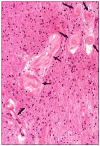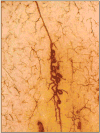Microvascular changes in the white mater in dementia
- PMID: 19268311
- PMCID: PMC2713367
- DOI: 10.1016/j.jns.2009.02.328
Microvascular changes in the white mater in dementia
Abstract
Our studies of the brain microvascular system have focused on some aspects not commonly studied by other research groups because we use some techniques not often used by others. Our observations tend to add new details to the pathological picture rather than contradict the mainstream findings. We use large, thick celloidin sections which provide a three dimensional view of vascular networks, and alkaline phosphatase (AP) staining which allows one to differentiate between afferent and efferent vessels. We found millions of lipid microemboli in the brains of patients after cardiac surgery, and concluded that they caused vascular dementia in many patients. We previously proposed an animal model of vascular dementia using brain irradiation, which induces capillary loss. Lipid emboli might also be used to create an animal model of vascular dementia. The deep white matter is vulnerable to chronic hypoperfusion because the blood vessels supplying this region arise from the border-zone and have the longest course of all vessels penetrating the cerebrum. In cases with leukoaraiosis (LA), we found periventricular venous collagenosis (PVC), resulting in stenosis. Thirteen of 20 subjects older than 60 years had PVC, and 10 of 13 subjects with severe PVC had LA. Vascular stenosis might induce chronic ischemia and/or edema in the deep white matter, leading to LA. We suggest three mechanisms for a possible genetic predisposition to PVC: i) a predisposition to excessive venous collagenosis; ii) an indirect effect that causes chronic periventricular ischemia with a reactive over-production of collagen; and iii) mechanical damage to small vessels due to increased pulsatile motion. We found tortuous arterioles supplying the deep white matter beginning at about age 50. We also found a trend toward an increase in tortuosity in LA. If tortuosity is a factor in LA, it is probably significant in only a subset of cases. String vessels, remnants of capillaries, occur commonly in the brain, and are increased in ischemia, AD, and irradiation. Capillary injury or shutdown of blood flow can lead to capillary loss and string vessel formation. We found string vessels in brains from preterm babies to the very old. They seem to disappear after some months or years. We found an early loss of capillaries in LA, followed in a few years by the disappearance of string vessels. LA lesions do not progress to cortical cavitating lesions. Our findings raise three questions. 1. Why is the capillary loss arrested before infarction? 2. Why is there a floor below which the vascular density will not fall? 3. Why does the process which initiates string vessels shut down? We explain the vascular changes in LA as follows. LA induces apoptosis with loss of oligodendrocytes. Capillaries and neuropil are lost. Increased oxygen extraction from the blood in the deep white matter in LA implies that there are too many cells for the remaining capillaries. Thus, the capillaries appear to die first. But why do they stop dying? Perhaps a minimum number of capillaries are needed to transport the arterial blood to the venous system. Once the capillaries stop dying, no more string vessels are formed, and the string vessels gradually disappear.
Figures




References
-
- Brown WR, Moody DM, Challa VR. Cerebral fat embolism from cardiopulmonary bypass. J Neuropathol Exp Neurol. 1999;58:109–19. - PubMed
-
- Moody DM, Bell MA, Challa VR, Johnston WE, Prough DS. Brain microemboli during cardiac surgery or aortography. Ann Neurol. 1990;28:477–86. - PubMed
-
- Brown WR, Blair RM, Moody DM, Thore CR, Ahmed S, Robbins ME, Wheeler KT. Capillary loss precedes the cognitive impairment induced by fractionated whole-brain irradiation: A potential rat model of vascular dementia. J Neurol Sci. 2007;257:67–71. - PubMed
-
- Brown WR, Thore CR, Moody DM, Robbins ME, Wheeler KT. Vascular damage after fractionated whole-brain irradiation in rats. Radiat Res. 2005;164:662–68. - PubMed
-
- Moody DM, Thore CR, Anstrom JA, Challa VR, Langefeld CD, Brown WR. Quantification of afferent vessels shows reduced brain vascular density in subjects with leukoaraiosis. Radiology. 2004;223:883–90. - PubMed
Publication types
MeSH terms
Grants and funding
LinkOut - more resources
Full Text Sources
Other Literature Sources
Medical

